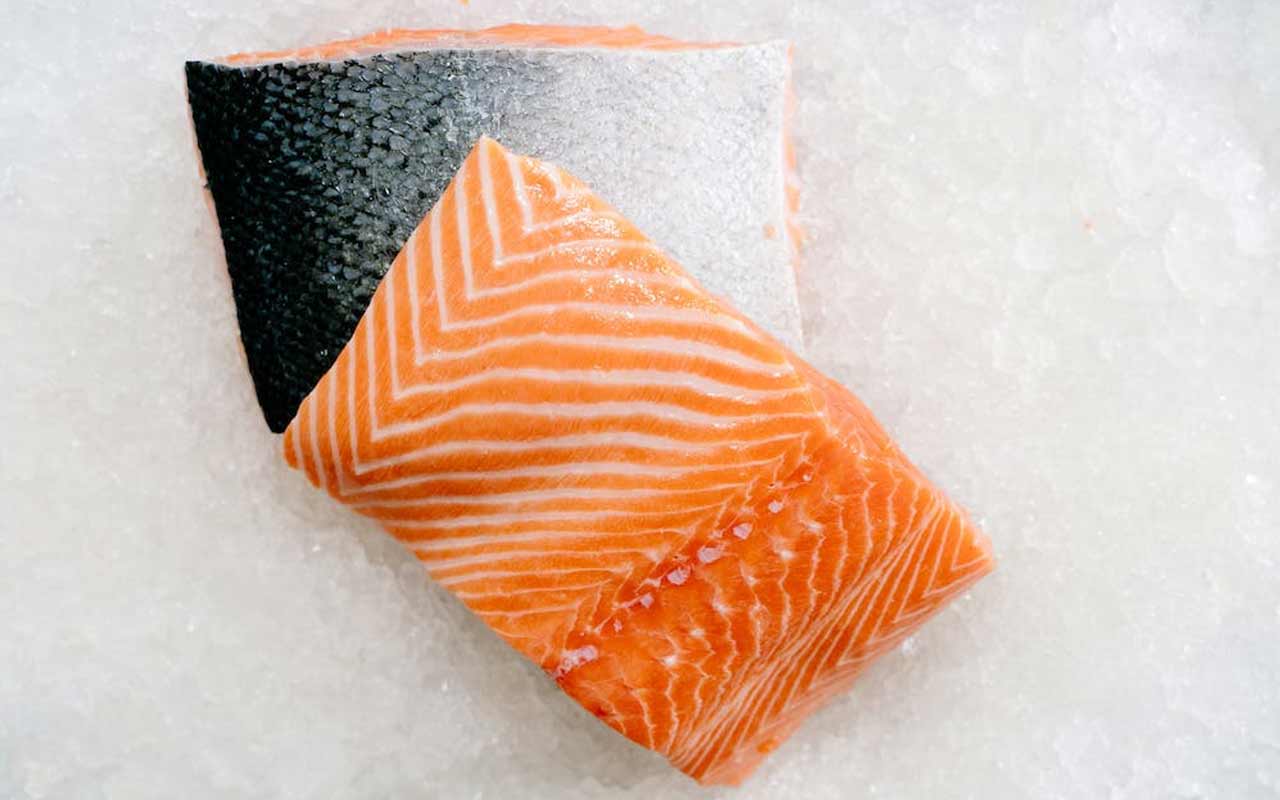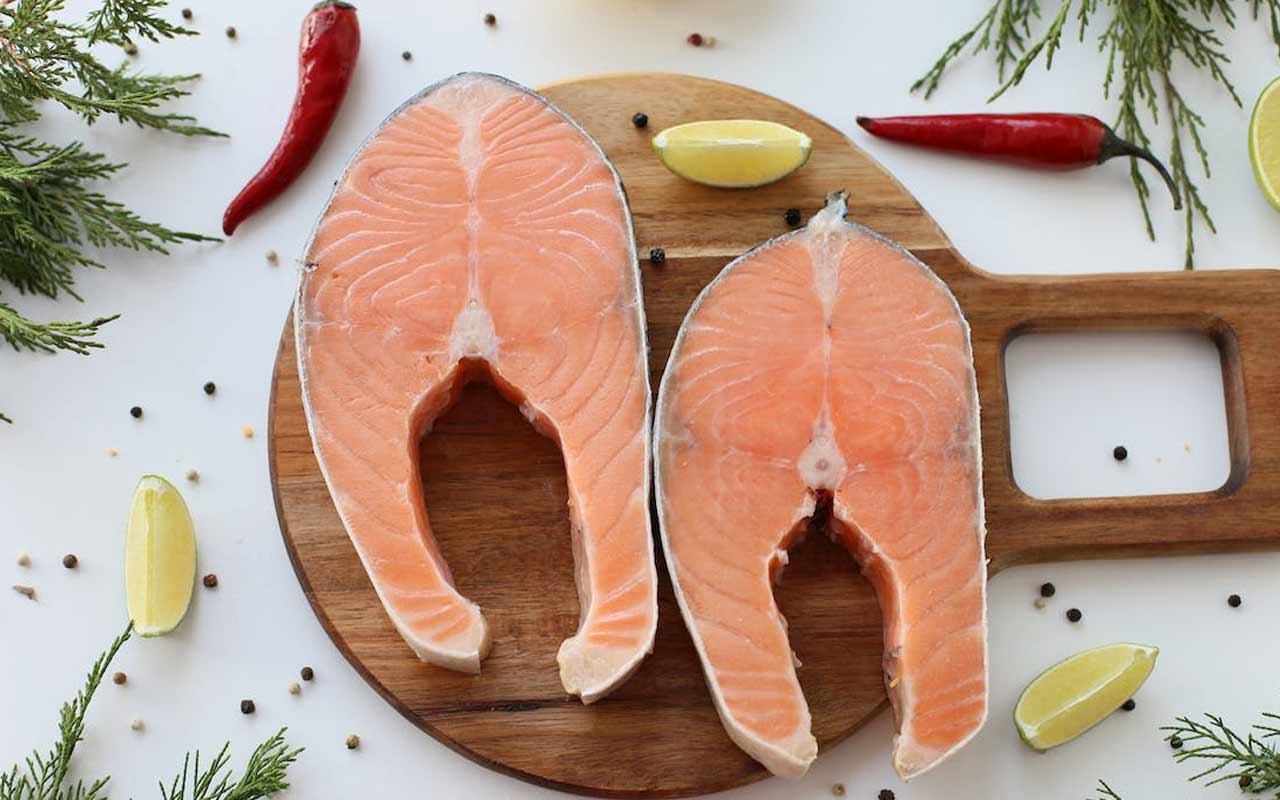Salmon is always a food of choice for many people because of its delicious taste, richness in processing, and the health benefits that it brings. But how much salmon eat per day is enough, what will happen if you eat too much? Let’s find out together.
Table of Contents
Salmon Nutrition Info
Salmon is low in saturated fat, high in good protein, and is also one of the richest food sources of vitamin B12, potassium, iron, and vitamin D.

| Energy | 142 kcal (590 kJ) |
|---|---|
| Fat | 6.34 g |
| Protein | 19.84 g |
| Vitamin | |
| Vitamin A | 40 IU |
| Minerals | |
| Calcium | (first%) 12 mg |
| Iron | (6%) 0.80 mg |
| Magnesium | (8%) 29 mg |
| Phosphorus | (29%) 200 mg |
| Kali | (ten%) 490 mg |
| Sodium | (3%) 44 mg |
| Zinc | (7%) 0.64 mg |
| Other elements | |
| Water | 68.50 g |
| Approximate percentages using reference food intakes (US Recommendations) for adults. Source: USDA Nutrition Database | |
Based on the nutritional value table above we see, with just 100g (3.5 oz) of salmon can provide up to 41% of the daily recommended protein and at least 20% of vitamins B3, B5, B6, B12, Vitamin D, vitamin E, and selenium are recommended daily for 1 adult.
The vitamin B12 in salmon keeps blood and nerve cells working properly, which helps make DNA. In addition, salmon is rich in omega-3 fatty acids, which are “essential” fatty acids for the body, helping to reduce the factors that cause cardiovascular diseases (including heart attacks and strokes) and cancer. , dementia and Alzheimer’s disease reduce rheumatoid arthritis.
Because of those benefits, experts recommend that adults eat at least twice a week of seafood, especially fish high in omega-3s like salmon. Pregnant women and young children should avoid fish high in mercury but should include salmon in their diets.
The health benefits of omega-3 cannot be denied. But if the body is given large amounts of omega-3 in supplements, it can cause bleeding problems when taking some anticoagulants.

Salmon is also a good source of vitamin D and calcium. However, for higher nutrient content, it is better to choose wild-caught salmon over farmed salmon. Wild salmon is rated to contain more omega-3s and vitamins and less saturated fat.
Besides, there is also a lot of controversy about the quality and benefits of both wild and farmed salmon. Some say that wild fish has lower levels of chemicals and antibiotics than farmed salmon.
But others argue that choosing farmed salmon is a smart choice because of the legality and compliance with regulations governing the growth and harvesting of fish.
The risk in farmed salmon is the potential for Polychlorinated Biphenyls contamination. Like so many other farmable fish, salmon is highly susceptible to contamination by pollutants in the air and water. The chemicals, called Polychlorinated Biphenyls (PCBs), are known carcinogens linked to birth defects.
People who regularly eat contaminated farmed salmon may be at risk of developing amnesia, which in the long term can lead to dementia.
The impressive health benefits of salmon

Salmon is an oily fish with a rich amount of fats. It is one of those nutritious foods that provide nutrients and may reduce risk factors for a number of diseases.
Uncooked salmon has a higher content of valuable nutrients. Cooking salmon at high heat can reduce its nutritional value, especially the amount of omega-3 fatty acids.
If comparing the nutritional value between salmon and some other seafood, such as scallops, it is clear, salmon is superior to Scallops in the content of Vitamin B12, Vitamin B6, Vitamin B3, Selenium, Vitamin B5, Vitamin B2, Copper, and Vitamin B1.
Meanwhile, Scallops have a higher phosphorus content than salmon. Salmon meets your daily Vitamin B12 needs 74% more than Scallops. The amount of Vitamin B1 in salmon is also 32 times higher than that of Scallops.
Here are 11 amazing health benefits of salmon.
Salmon is rich in Omega-3 fatty acids
Salmon is one of the best sources of omega-3 fatty acids for the body.
In 100 grams of farmed salmon, there are 2.3 grams of long-chain omega-3 fatty acids, while the same serving of wild salmon contains 2.6 grams. Unlike most other fats, omega-3 fats are considered “essential,” meaning they must be obtained from the diet because the body cannot make them.
Although there is no fixed amount of omega-3 fatty acids that are recommended daily, many health organizations recommend that healthy adults get a minimum of 250-500mg of a combination of EPA and DHA per day.
EPA and DHA have been documented to provide a number of health benefits such as reducing inflammation, lowering blood pressure, reducing the risk of cancer, and improving the function of the cells that line the arteries.
A 2012 analysis of 16 controlled studies found that taking 0.45 to 4.5 grams of omega-3 fatty acids per day significantly improved arterial function. Eating at least two servings of salmon a week can help meet your body’s need for omega-3 fatty acids.
Provide protein

Like omega-3 fats, protein is an essential nutrient that the body must obtain from the diet. Protein helps the body recover from injury, protects bone health, and maintains muscle mass during weight loss and the aging process.
Adding salmon to your diet and combining it with exercises that target muscle groups will help shape and increase muscle mass significantly. For example, if you do exercises that target the glutes, adding salmon to your diet will accelerate the growth of lean muscle in your buttocks, helping you to quickly have bigger and rounder butts.
Recent research has found that for optimal health, each meal should provide at least 20-30 grams of high-quality protein. One serving of salmon contains about 22-25 grams of protein.
Salmon is high in Vitamin B
Here is the content of B vitamins in 100 grams of wild salmon:
- Vitamin B1 (thiamine): 18% of the RDI
- Vitamin B2 (riboflavin): 29% of the RDI
- Vitamin B3 (niacin): 50% of the RDI
- Vitamin B5 (pantothenic acid): 19% of the RDI
- Vitamin B6: 47% of the RDI
- Vitamin B9 (folic acid): 7% of the RDI
- Vitamin B12: 51% of the RDI
These vitamins are involved in a number of important processes in the body, including converting food into energy, creating and repairing DNA, and reducing inflammation. Studies have shown that all B vitamins work together to maintain optimal brain and nervous system functioning.
Salmon provides potassium
This is especially true for wild-caught salmon, which provides 18% of the RDI per 100 grams, compared with 11% of farmed salmon. Potassium helps control blood pressure. A large analysis of 31 studies found that potassium supplements lower blood pressure, especially when added to a high-sodium diet.
Supplying Selenium
Selenium is a mineral found in some foods. It is considered a trace mineral, which means the body only needs small amounts of it. However, getting enough selenium in the diet is important.
Studies have shown that selenium helps protect bone health, reduces thyroid antibodies in people with autoimmune thyroid disease, and may reduce the risk of cancer. 100 grams of salmon provides from 59-67% selenium. Eating salmon and other high-selenium seafood may improve blood selenium levels in people with diets low in this mineral.
Contains the antioxidant Astaxanthin
Astaxanthin is a compound related to the carotenoid antioxidant, astaxanthin that gives salmon its red pigment. Astaxanthin reduces the risk of heart disease by reducing the oxidation of bad cholesterol and increasing good cholesterol.
One study found that 3.6 mg of astaxanthin per day was enough to reduce the oxidation of LDL cholesterol, potentially reducing the risk of heart disease. In addition, astaxanthin works with salmon’s omega-3 fatty acids to protect the brain and nervous system from inflammation.
What’s more, astaxanthin may even help prevent skin damage and help you look younger. Every 100 grams of salmon contains about 0.4 -3.8 mg of astaxanthin.
Reduce the risk of heart disease
Eating salmon on a regular basis can help fight heart disease. This is largely due to the omega-3 content found in salmon. Research shows that when the balance of this two omega-6 and omega-3 fatty acids is lost, the risk of heart disease increases.
In a four-week study of healthy men and women, consuming two servings of farm-raised salmon per week increased blood levels of omega-3s by 8%-9% and decreased omega-6 levels. Additionally, consuming salmon reduced triglycerides and increased levels of omega-3 fats more than fish oil supplements.
Salmon helps control weight
Regular salmon consumption can aid weight loss. Like other protein-rich foods, it regulates the hormones that control appetite. In addition, metabolic rate increased more after eating protein-rich foods like salmon.
Research shows that the omega-3 fats in salmon can promote weight loss and reduce belly fat in overweight people. Another study in children with the non-alcoholic fatty liver disease found that supplementing with DHA, the omega-3 found in salmon, significantly reduced liver and belly fat.
Anti-inflammatory
Salmon can be a powerful weapon against inflammation. Many experts believe that inflammation is the root cause of most chronic diseases, including heart disease, diabetes, and cancer. Several studies have found that eating more salmon helps reduce markers of inflammation in people at risk for these and other diseases.
In an 8-week study in middle-aged and elderly Chinese women, daily consumption of 80 grams of salmon resulted in a reduction in inflammatory markers TNF-α and IL-6.
Protecting brain health
More and more studies show that including salmon in the diet can improve brain function. Fish oil can reduce symptoms of depression, protect fetal brain health, reduce anxiety, and age-related memory loss and reduce the risk of dementia.
In one study of people 65 and older, eating salmon at least twice a week was associated with a reduction in age-related memory loss. In another study, people with normal brain function who ate fish regularly were found to have more gray matter in their brains.
Salmon is a delicious food
The salmon is undeniably delicious. It has a unique, delicate flavor with a less “fishy” flavor than much other fish, such as sardines and mackerel. Salmon is also easy and versatile to cook as steamed, sautéed, smoked, grilled, or boiled, and can also be eaten raw in sushi and sashimi.
Additionally, canned salmon is a quick and cheap option. Money offers the same impressive health benefits as fresh fish. In fact, almost all canned salmon is wild, not farmed.
How much salmon to eat per day?

Although you can’t eat raw salmon skin, cooked salmon skin is a good source of omega-3 fatty acids, vitamins B and D, and minerals like niacin and phosphorus.
Many studies have even shown that it is salmon skin that has the highest concentration of these hard-to-find fatty acids. Salmon skin can be processed separately, making dishes such as crispy salmon skin, grilled salmon skin, or combined with salad, and sushi.
Salmon is a rich source of healthy nutrients, but eating too much can cause problems. Experts offer different amounts of salmon that are safe to eat each week.
While some research suggests that consuming up to three servings per week may be beneficial, the FDA recommends eating 8 ounces of salmon per week based on a 2,000-calorie diet. Of course, you can eat salmon every day but in smaller portions.
Thus, if you take 8 ounces in a week divided by the number of days you will eat salmon in a week, you will get a serving per day. For example, if you eat salmon 2 days a week, you shouldn’t eat more than 8:2 = 4 ounces per day. If you’re pregnant, the FDA recommends eating 8 to 12 ounces of seafood per week.
For better health, eat a variety of fruits, vegetables, and nuts. Seafood should also be diverse, not just eating salmon weekly. You can diversify your meals from seafood sources lower in mercury than salmon such as Tuna, Rainbow trout, Pacific halibut, Mackerel, Cod, Sardines, and Herring.
